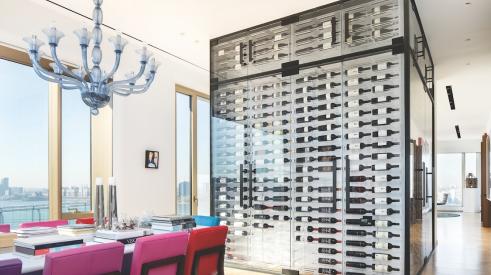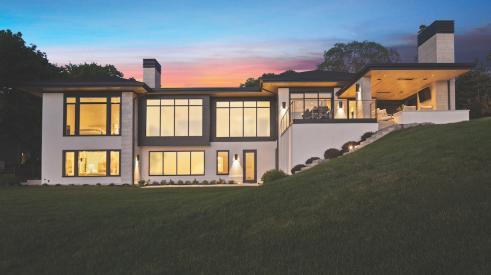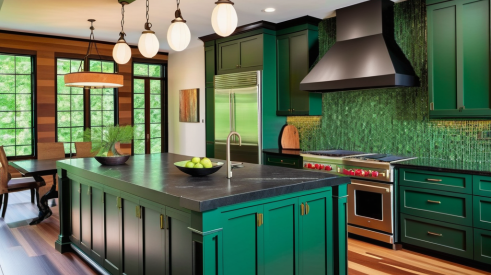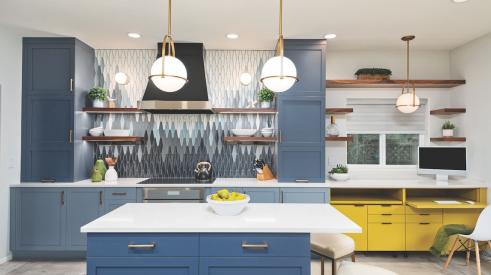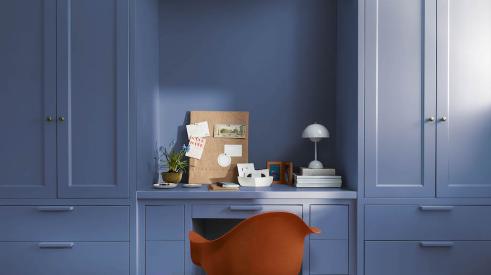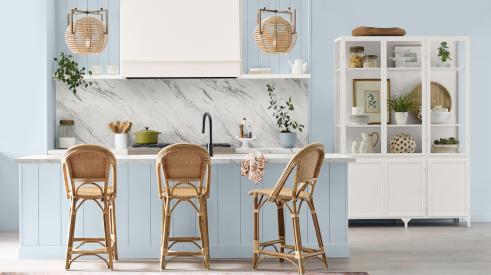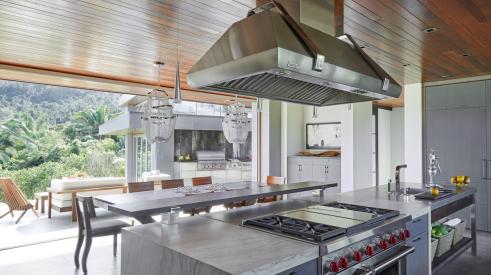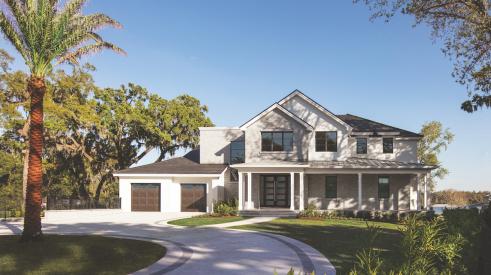The problem sounded simple: A leaky refrigerator caused some floor damage that needed to be repaired. But in an 18th-century stone house, almost no remodeling is simple.
That’s especially true of this Philadelphia-area farmhouse, which has been in Jennifer Rittenhouse Seavy’s family for 10 generations. Various updates have been made in the centuries since Rittenhouse’s ancestor bought the property from William Penn, but the house is proudly historic and carefully protected by the family.
Pulling up the flooring in the kitchen — itself a 1960s construction within the house’s original walls — spurred Rittenhouse and husband George Seavy to resolve the room’s other flaws, completely remodeling the narrow, dark, congested space and opening it to an adjoining 1960s sunroom.
“I knew that the work would include modifying an outside, weight-bearing stone wall” between the two rooms, says Rittenhouse, “and that we needed an engineer as well as an architect. I interviewed a few contractors, but each was missing a component — engineering experience, or an architectural approach, or respect for old homes.”
Not to mention that the contractors were leery of tackling the stone wall.
Just one company, Harth Builders, Spring House, Pa., had the whole package, including in-house architects and a design coordinator; engineering expertise (both owners of the father-and-son company are engineers); a track record of sensitive treatment of old buildings; a lead carpenter system for efficient, on-site project management; and the confidence to modify the stone wall. As a multigenerational company, Rittenhouse also appreciated that Harth brought “the perspective of years” to a house where three generations of her family resided. She hired Harth for the kitchen renovation, adding a variety of other interior and exterior updates as change orders.
The Wall
At 870 square feet, the space in the kitchen-sunroom area was ample, says Rittenhouse, but “very wrongly distributed.” All the appliances in the long, galley kitchen were crowded within 4 feet of each other, and the sit-down area was confined to a skimpy peninsula that blocked traffic flow. Rittenhouse wanted better circulation; bigger and better-distributed appliances and work areas; more storage; improved lighting; and more space for gathering, including a gracious sit-down counter area large enough for five stools.
Harth’s design widened the traffic path, spread work areas around the kitchen, and replaced the peninsula with a versatile center island. A gracefully curved counter with generous sit-down space smoothly integrates the kitchen with the sunroom, which became a comfortable gathering space complete with wet bar and dining table.
Building the new counter between rooms meant removing a 2-foot thick stone wall and inserting beams to support the floor above, all without compromising the historic structure. The first step was soil testing to assure that the basement portion of wall could hold the new load. Second step: dismantling the first floor wall.
“That wall was stones fitted to each other — no lathe, just plaster right onto the stone,” says lead carpenter Andrew Lemmon, CLC. This was not a job for power tools and cranes. “We un-built the wall piece by piece using mauls and chisels,” Lemmon says. It took two or three workers 80 man hours to clear an opening from chest height to ceiling.
At that point seven men lifted a slim, 400-plus pound steel beam through a bay window and shimmied it into place, where it was mortared into position. With that beam in the wall to stabilize the load, “it was less stressful to install a second beam” alongside it to double the load-bearing strength, says Lemmon.
Harth production coordinator Jeremy Riggall, CR, admits that “Andrew lost sleep” over the installation, fearing major shifting. Both beams displayed some deflection, but movement was minimal. A few cracks of cosmetic concern appeared in the stucco exterior; Lemmon caulked the cracks for weather tightness, then applied fiberglass-based mortar and painted them.
Curve Balls
“The first two-and-a-half to three weeks,” says Lemmon, the project “was full of curve balls related to the age of the house.” Due to the vibration of demolition, for example, corroded pipes burst in the basement. “We had a geyser,” says Lemmon. Another figurative curve ball came from the kitchen floor.
Over the decades, the adhesive holding the hardwood parquet to the subfloor had become stronger than the resins binding the parquet. “A push-behind floor stripper machine only shredded the parquet flooring or pulled apart the plywood substrate,” Lemmon says. To provide a smooth subfloor for new flooring, “we cut out the layers of old flooring to reach the original 1x4 tongue and groove subfloor.”
It was amazing, he observes, “how fragile parts of the house could be, and how strong — like a fortress — other parts [such as the walls] could be.”
More old-house challenges emerged as production continued. “There was no space between the first floor and second floor” for wiring, says Lemmon; the second floor subfloor rested directly on the beams and drywall of the kitchen ceiling.
“We cut a 3/4-inch groove in the floor with a router,” he says, laid the wires in the groove, and capped them with a commercial aluminum channel. To upgrade the electrical system elsewhere in the house, Harth crews fished wires from behind lathe and plaster.
As a base for installation of a pendant light over the kitchen island, Lemmon attached old floorboards to the exposed beams. To channel new plumbing conduit under the kitchen, he worked around the
basement portion of the stone wall. And to house HVAC returns behind the sunroom wet bar, he snaked flexible trunks around the recessed lighting above the peninsula.
The kitchen floor sloped an inch-and-a-half over 20 feet. “We couldn’t just shim up one side of the cabinet” run to compensate, says Lemmon, “because the beams came down so low.” He had the cabinet rep come out to the job site and devise a solution, which involved slightly lowering cabinets at one end of the room and raising them at the other.
Where kitchen meets sunroom, the floor presented other problems. The floor levels of the two rooms differed, and it was difficult to find a kitchen flooring material that would complement the old house and the tiled sunroom.
Through the Internet, Rittenhouse located 75-year-old longleaf pine in Maryland. The miller came to the house to examine the space and determine the right board thickness for a smooth transition between rooms. The boards vary in width, as do those elsewhere in the house.
Creating Curves
When Harth design coordinator Cindy Aman asked what aesthetic features Rittenhouse loved about her old house, she said the exposed beams and the rounded walls framing deep window openings were favorites. Taking those cues, Harth included exposed beams and numerous curved elements in the renovated kitchen.
The cabinetry includes radius cabinet doors, curved crown and shoe molding, turned pilasters, carved wood corbels, a range hood with curved profile on all three sides, and arched niches that match those in the old house’s built-in corner hutches.
Softly curved end walls, including one that encloses the flue from the basement hearth, create wide, space-enhancing transitions between rooms. The spackle on the curved walls had to be perfect, says Lemmon, because light reflecting off the curved surfaces “would show every blemish. We did a lot of touch-up to make them as flawless as could be.”
Ogee and bull nose edge profiles on the granite tops around the room and on the center island repeat the elegant curve. Installing the curved granite surface on the peninsula between kitchen and sunroom was “a huge challenge,” says Aman. Overhanging 27 inches beyond the cabinet base, the broad counter needed heavy duty support but could not have posts that would block legroom for people seated at stools.
“We came up with a counter balance support using ¼-inch thick steel plate in a Z-shape,” says Lemmon.
“I learned a lot on this project,” Lemmon says. “Every aspect of it was a challenge. But I know I cannot get caught up in all the variables. My goal is to produce a final product that achieves customer satisfaction.”
He and Harth Builders clearly accomplished that with the Rittenhouse kitchen.
“It’s a great project,” says Rittenhouse, adding, “The process was the amazing part. There was only one day that there wasn’t someone in my house working.” Producing such a complex job efficiently and well is “an art form,” she says.
Nothing is simple when it comes to rehabbing a historic home
Add new comment
Related Stories
This New Tech Turns Any Countertop into a Wireless Charger
FreePower for Countertop has swept awards for its innovation—and the company claims installing it is "as straightforward as cutting a sink"
Designing, Building, and Installing a Luxury Custom Wine Cube
An 11-foot wine cube enveloping a pantry is the stand out feature of this customized New York penthouse
Marvin Releases Switchable Privacy Glass Window
The privacy glass windows can be purchased from Marvin's Direct Glaze windows
Building A Small Projects Division from the Ground Up
Through hard work and careful strategy, Harth Home Services has seen big growth
Client Design Choices in the Time of Social Media and AI
Social media speeds up the trend cycles, and now artificially created images are falling into homeowners' hands
Design Trends to Watch in 2024
What’s in and out for the upcoming year? Remodeling designers share insights
Insights for Designing Outdoor Kitchens
Was the pandemic-fueled thirst for outdoor kitchen remodels and additions a fluke, or is it here to stay? Plus: The top design considerations for outdoor kitchens
Home Run Remodeling Lessons: The New American Remodel 2023
A final look at The New American Remodel 2023





